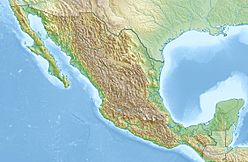Árbol del Tule facts for kids
Quick facts for kids Árbol del Tule |
|
|---|---|

Full width of trunk
|
|
| Species | Montezuma cypress (Taxodium mucronatum) |
| Coordinates | 17°02′47.4″N 96°38′10″W / 17.046500°N 96.63611°W |
| Girth | 42.0 m (137.8 ft) |
| Date seeded | 400 – 600 AD |
El Árbol del Tule (which means The Tree of Tule in Spanish) is a very famous tree. You can find it in the church grounds in the town of Santa María del Tule, in the Mexican state of Oaxaca. This town is about 9 kilometers (5.6 miles) east of Oaxaca City.
This amazing tree is a type of cypress called a Montezuma bald cypress. People also call it an ahuehuete, which means "old man of the water" in the Nahuatl language. It holds the record for having the widest tree trunk in the entire world! For a while, it was even considered to be a UNESCO World Heritage Site, but it was later removed from the list.
Contents
How Big and How Old Is It?
Its Incredible Size
In 2005, the trunk of El Árbol del Tule was super wide. Its circumference (the distance around it) was about 42 meters (138 feet). This means its diameter (the distance across it) was around 14 meters (46 feet)!
However, the trunk isn't perfectly round. It has big, bumpy parts called buttresses. If you imagine smoothing out these bumps, the trunk's diameter would still be a huge 9.38 meters (30.8 feet). This makes it slightly wider than the next biggest tree known, a giant sequoia.
Measuring the tree's height is tricky because its top branches spread out so much. In 2005, a laser measurement showed it was about 35.4 meters (116 feet) tall.
One Tree or Many?
Because the tree is so incredibly large, people first thought it was actually several trees growing very close together. But scientists did DNA tests, and these tests proved that it is indeed just one single tree! There's still a thought that it might be one tree with many trunks growing from its base.
How Old Is This Giant?
No one knows the exact age of El Árbol del Tule. Some guesses say it's between 1,200 and 3,000 years old. There's even a claim that it's 6,000 years old! But the best scientific guess, based on how fast trees grow, is that it's about 1,433 to 1,600 years old.
Local Zapotec legends tell a story about the tree. They say it was planted around 1,400 years ago by a priest named Pechocha. He was a priest of Ehecatl, the Aztec wind god. This legend's age matches up pretty well with what scientists believe! The tree is also located on a very old, sacred site, which supports this ancient story.
The "Tree of Life"
El Árbol del Tule is sometimes called the "Tree of Life". This is because if you look closely at its bumpy, gnarled trunk, you can imagine seeing shapes of different animals! It's like a natural puzzle.
As part of a special project, local schoolchildren often give tours to visitors. They love to point out the animal shapes they see on the trunk, like jaguars and elephants. It's a fun way to explore the tree!
Keeping the Tree Healthy
In the 1990s, people started to worry about the tree's health. Reports said that El Árbol del Tule was slowly dying. This was because its roots were being damaged by not enough water, pollution, and the many cars driving on a nearby highway every day. It's important to protect this amazing natural wonder.
See also
 In Spanish: Árbol del Tule para niños
In Spanish: Árbol del Tule para niños
- List of individual trees
- List of oldest trees



